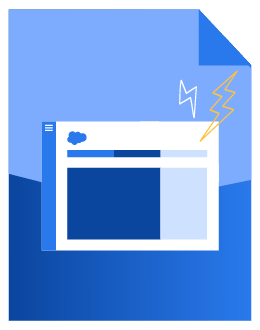Your Salesforce Lightning migration should be handled in 3 main stages: Discover, Roll Out, and Optimize. This chapter focuses on the discovery portion of this process.

In the discovery stage, identify key CRM objectives and start building a migration plan around those goals. When first developing your Lightning migration plan, consider all the different factors — beyond just configuring the software — that come into play.
What should you accomplish in the discovery stage of your migration?
- Learn as much as you can about Lightning
- Understand the different features available
- Identify key stakeholders & assemble a committee
- Educate your company about how Lightning will improve their processes
- Perform a gap analysis on your current Salesforce instance
A Salesforce migration is more than just a software rollout. Because Salesforce is often integral to a company’s operations, migrating requires a significant amount of collaboration.
Collaborate with people throughout the migration process: stakeholders with decision-making authority, super users who can support the less tech-savvy, and ultimately your general users who will need training on the new platform.

Download the Salesforce Lightning Migration Guide
Don’t have time to read the whole guide right now? Download the PDF version of the guide.
Identify & collaborate with Salesforce stakeholders
No matter your role or comfort level with Salesforce’s technology, you need to involve your key stakeholders early in the process. Stakeholders should form a steering committee, which will guide your company through the migration process.
The varying perspectives and different types of users on a steering committee make it likely they’ll ask questions about the new configuration that you hadn’t considered yet.

Having an executive sponsor at the helm of the steering committee is essential because they have the authority to make decisions about organizational processes. Executive and stakeholder support helps ensure your implementation plan is followed properly.
The steering committee for your Lightning migration should include stakeholders from all relevant roles, such as sales management, sales operations, super users, and Salesforce admins.
If you don’t have a dedicated Salesforce admin, EBQ has certified administrators who are available to help throughout the migration process. Visit our CRM Consulting Services page to learn more about our expertise and experience.
CRM gap analysis
A CRM gap analysis helps you identify opportunities to improve workflows or metrics, as well as any issues with your platform configuration. Your Salesforce migration is a perfect chance to perform this analysis and upgrade your configuration.
Salesforce has developed its own tools to help you handle the gap analysis portion of your migration. One of the most practical tools is the Lightning Experience Readiness Report, which can be accessed within Salesforce.
The Readiness Report generates a PDF that estimates how many hours of work it will take to complete the migration, as well as how much Lightning will improve critical metrics for your business. It also gives you explicit warnings about features that will no longer work in Lightning, such as a list of JavaScript buttons you’re using.
The Readiness Report is an excellent way to evaluate your Salesforce, but it doesn’t necessarily cover all relevant features and areas. To help users run a more comprehensive gap analysis, Salesforce has also produced a Lightning Experience Enablement Pack.
But even with all of Salesforce’s self-service tools, we recommend having someone knowledgeable in both the technical and business aspects of Salesforce evaluate your instance to identify any potential disruptions and provide recommendations tailored to your organization’s process.
At EBQ, we offer platform audits and migration services to help companies fill gaps in their CRM structure and ensure a successful migration. Having worked with hundreds of companies, our certified admins know the best CRM practices for a number of industries. Reach out to our team if you need some help finding any gaps in your migration plan.
Demonstrate & get stakeholder buy-in
Once you’ve learned a bit about Lightning and roughly understand the scale of your migration project, it’s time to get buy-in from your leadership and users.
It can be difficult to convince stakeholders that migrating is a worthwhile investment of time and effort. Take everything you’ve learned through your discovery stage research and educate them on how Salesforce Lightning will improve your organization’s data and bottom line.
The Enablement Pack mentioned in the last section includes a presentation for pitching Lightning to your stakeholders. We also suggest performing a demonstration of Salesforce Lightning through a developer instance as visual support for your pitch.
Now that your organization is prepared to take on a comprehensive Salesforce migration, let’s move onto creating the implementation plan.


